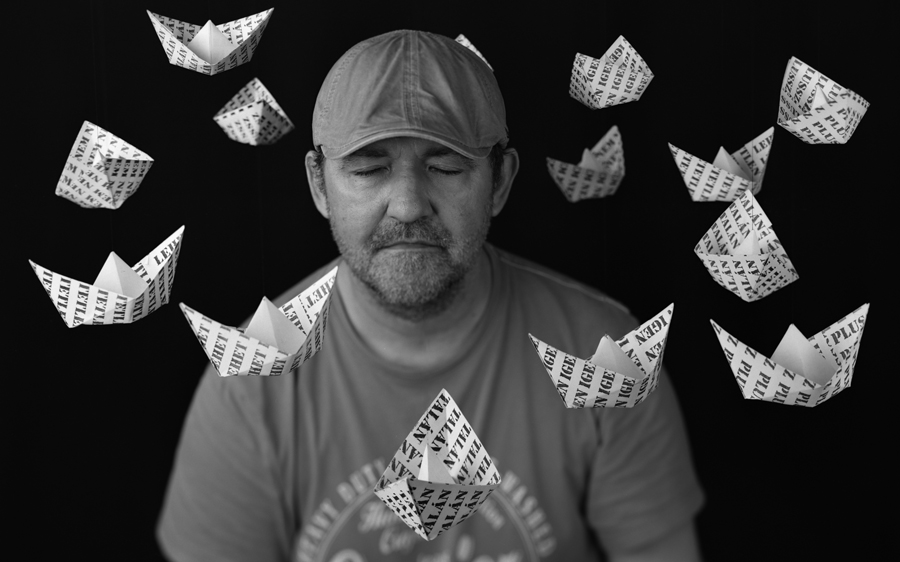About me


Lajos Síró (Hajdúnánás, 1964 - ) graphic designer, photographer, his photos are placed on the border of these two artistic areas.
1994. Member of the Union of Hungarian Fine Artists. 1995. Member of the Association of Hungarian Photo artists.
1996. Member of Studio of Young Photo artists. 1999. Member of Association of Hungarian Graphic Artist.
Studies:
Nyíregyháza Bessenyei György Teacher Training College, Geography and Arts professionals
ÖTVENÖT / FIFTY-FIVE
ISBN 978-963-89750-9-6
The exhibitions being attached to the artist's fifty-five birthday.
B24 Galéria, Debrecen
(2019. 09. 19 − 2019. 10. 20.)
Városi Kiállítóterem, Tiszaújváros
(2019. 10. 22 − 2019. 11. 08.)
Herman Ottó Múzeum – Miskolci Galéria
(2019. 11. 28 − 2020. 01. 11.)
The book was ready for the exhibition opening of the b24 Gallery, which is also the catalogue of the exhibitions.

Photography's Antiquarian Avant-Garde: The New Wave in Old Processes
Lyle Rexer | ISBN-10: 0810904020 | ISBN-13: 9780810904026
Regard Hongrois / Magyar tekintet
Photographes hongrois au jardin du Palais Royal.
ISBN 10: 963007804X / ISBN 13: 9789630078047
Published by Editions Mai Mano, Budapest, 2001
LEAP / SZÖKŐ
György Boros, Tamás Nagy, Lajos Síró, István Soltész
Leap Day Exhibition Series in Nyíregyháza 1996 • 2000 • 2004 • 2008
Thoughts were added to the photographs by: András Bán, Miklós Fucskó, Zsolt Karádi, Krisztián Kukla, Csaba Orosz, Lajos Parti Nagy
New York in another way.
Lajos Síró’s Exhibition
Élet és Irodalom /weekly cultural magazine/
22 September 2006, volume L, issue 38.
"To take a photograph is to align the head, the eye and the heart. It's a way of life."
Henri Cartier-Bresson
If we mention the name and concept of the city New York, all our prejudice and stereotypes immediately come into action. We even have entire linguistic and visual stores to imagine the virtual set-up of the city without any personal experience. However, Lajos Síró aspires to create his own city; he has silence instead of noise, he emphasizes tranquility instead of moving and pulsation, and instead of colors and lights, he operates with different tones of brown.
Many debates exist about the photographs when we attempt to define their role, importance and spread in fine arts. About how graphics and paintings as traditional media builds and institutionalize the photographs as a procedure – “Not the photography annexed the art, it rather happened vice versa.” – can be read in the catalogue of Műcsarnok’s photo exhibition in 2001. However, it is not well-known how fine arts infiltrate into photography, how the tool originally designed to document and capture becomes the representative of graphics and sometimes paintings. In the last 20 years, the free adaptation of technical development in photography including the mixture of traditional and the latest technical facilities resulted in the extension of photographic boundaries and limits. This tendency in the Hungarian photography has been prevalent since the early 1990s.
Lajos Síró makes fine art from a photograph. His works have been made with photosensitive material and optical system without any relation to the ‘classic’ photo-taking. His photos sometimes resemble panel paintings made by retouch pistol or graphics drawn with chalk, ink on adhesive slate.
The inventor of photography is Daguerre, a French scene-painter, who introduced his invention, daguerreotype in 1839. The argentotype – sepia method iron sepia print…etc. has been known by the professional photographers since 1842, and this technique was intensely used in practice between 1885 and the end of 1930s. Kallitype belongs the sepia method that has been working with photosensitive liquor made of exceedingly special compounds. This is the method Lajos Síró uses. He intends to document the remake; therefore, his fine item intense optics can document fire escapes, street furniture or ocean shore covered by wooden boards to be seen as architecture. Instead of documenting the consumer society’s ritual and cultic objects, he reduces the view to united space structure of plastic shapes. For Síró, the world’s objects, the built environment surrounding us are made in order that he can create a meticulously well-composed still-life. He also regards architecture as a sort of still-life. Therefore, his New York photos do not make the viewer discover the attributes of metropolis, they rather represent the interaction of man-made nature and architecture with natural phenomena. The warm and soft tone performance of the mysterious contemplations, cloud-covered, gigantic ‘building blocks’ is represented and instead of the vibration of the pulsating city, some kind of immobile consistence is shown. With gently tinged plastic surfaces, dull lights, reflections, the obsolete factures of building walls, Lajos creates a visual myth as if we were witnesses of New York in the 1920s. As we are looking at the photos, we are also waiting for the actors of a Hollywood gangster movies to appear from the era of alcohol prohibition. However, they are not coming and there is not even a car referring to the historical myth. The city and streets are empty, there is no evidence about the era. This is also the reason why some photos are eye-catching where huge billboards break the empty space without people. Nevertheless, we feel that these gigantic billboards are not individual segments of the city’s space, they rather belong to the real perception that forms Síró’s still-life.
Lajos Síró’s New York photos are evidently big city photographs that cannot be gainsaid. Apart from one or two spiritual clichés (Saint Thomas Cathedral, the ‘Flatiron Building’ designed by Daniel Burnham or the famous New York fire escapes), this visual experience can be lived and documented anywhere and anytime. It also might be the reason why he did not give location-related titles to the photographs. Moreover, with this recreation, the artist’s New York photographs primarily become the organic parts of Lajos Síró’s fine art and not his photography.
Lilla Szoboszlai